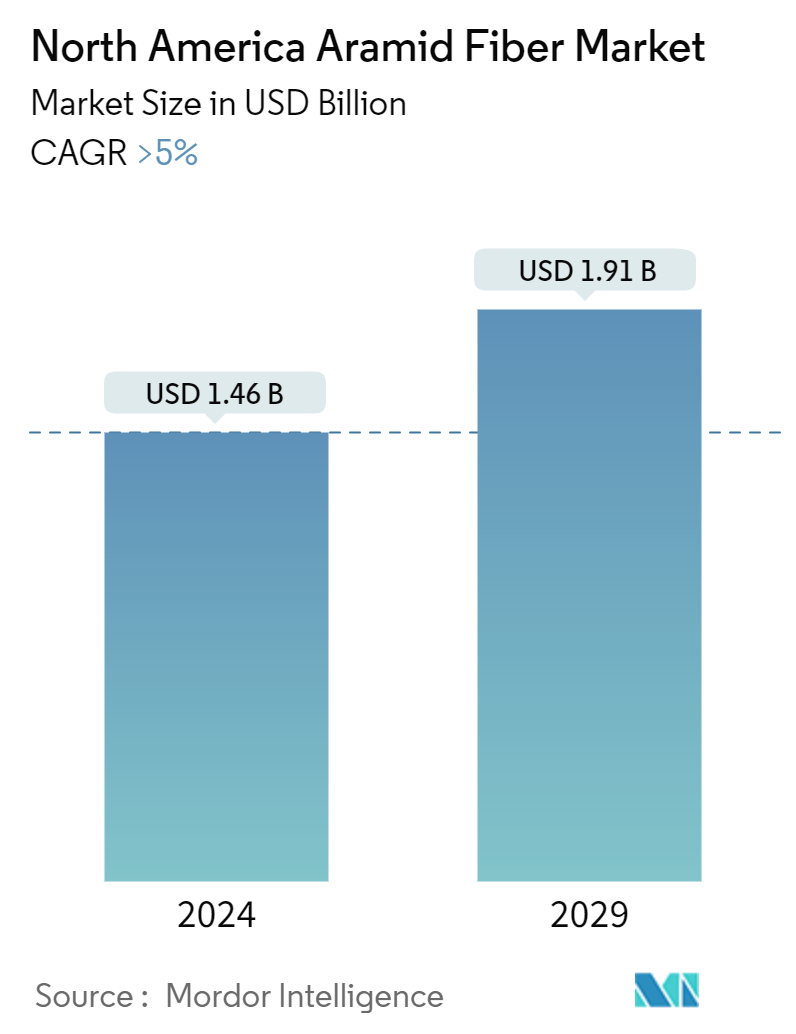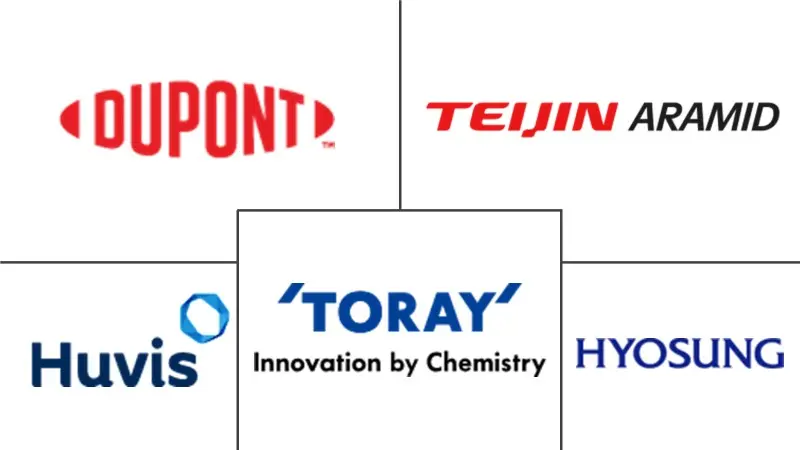Market Size of North America Aramid Fiber Industry

| Study Period | 2019-2029 |
| Base Year For Estimation | 2023 |
| Market Size (2024) | USD 1.46 Billion |
| Market Size (2029) | USD 1.91 Billion |
| CAGR (2024 - 2029) | > 5.00 % |
| Market Concentration | High |
Major Players
*Disclaimer: Major Players sorted in no particular order |
North America Aramid Fiber Market Analysis
The North America Aramid Fiber Market size is estimated at USD 1.46 billion in 2024, and is expected to reach USD 1.91 billion by 2029, growing at a CAGR of greater than 5% during the forecast period (2024-2029).
The North America Aramid Fibers Market had been negatively affected by the COVID-19 pandemic. The United States was worst hit by the COVID pandemic in the region. The COVID pandemic resulted in lockdowns in the United States, Canada, and Mexico, affecting the automotive, electrical and electronics, aerospace, and defense end-user industries, thereby affecting the market for aramid fibers. However, the market recovered well after the restrictions were lifted. The market recovered significantly, owing to the rise in consumption of aramid fibers in automotive, electrical, and electronics end-user industries.
- Over the short term, the increasing demand for lightweight materials in aerospace and defense industries, the increase in demand for lightweight materials in the automotive industry, and the rising usage of aramid fibers as a potential substitute for steel materials are excepted to drive the market.
- The non-biodegradable nature of aramid fibers and the increasing prices of raw materials are hindering market growth.
- The advancements in aramid materials manufacturing technology are expected to create opportunities for the market during the forecast period.
- The United States is expected to dominate the market due to the rising demand for aramid fibers from automotive, aerospace and defense, electrical, and electronics end-user industries. It is also expected to register the highest CAGR during the forecast period.
North America Aramid Fiber Industry Segmentation
Aramid fiber is an artificial, high-performance organic fiber manufactured from aromatic polyamides. The critical characteristics of aramid fiber include high strength, good resistance to heat, abrasion, and organic solvents, non-conductivity, and low flammability. It is mainly used for composites, ballistics, optical fiber cables, protective clothing against heat and chemicals, and others.
The North America aramid fiber market is segmented by product type, end-user industry, and geography. By product type, the market is segmented into para-aramid and meta-aramid. By end-user industry, the market is segmented into aerospace and defense, automotive, electrical and electronics, sporting goods, and other end-user industries (oil & gas, telecommunications, etc.).By geography, the market is segmented into the United States, Canada, and Mexico. The report also covers the market size and forecasts for the North America Aramid Fiber market for 3 major countries. For each segment, the market sizing and forecasts are provided in terms of value (USD).
| Product Type | |
| Para-aramid | |
| Meta-aramid |
| End-user Industry | |
| Aerospace and Defense | |
| Automotive | |
| Electrical and Electronics | |
| Sporting Goods | |
| Other End-user Industries (Oil & Gas, Telecommunication, etc.) |
| By Geography | |||||
|
North America Aramid Fiber Market Size Summary
The North America aramid fiber market is poised for significant growth, driven by increasing demand across various industries such as aerospace, defense, automotive, and electronics. The market, which experienced setbacks due to the COVID-19 pandemic, has shown resilience and is expected to expand steadily over the forecast period. The United States is anticipated to lead the market, benefiting from its robust aerospace and defense sectors, as well as its thriving automotive and electronics industries. The demand for lightweight materials, particularly in aerospace and defense applications, is a key factor propelling market growth. Additionally, the use of aramid fibers as a substitute for steel in automotive applications is gaining traction, further boosting market prospects.
Despite challenges such as the non-biodegradable nature of aramid fibers and rising raw material costs, advancements in manufacturing technologies present opportunities for market expansion. The aerospace industry, in particular, is increasingly incorporating aramid fibers into aircraft construction due to their temperature stability and durability. This trend is expected to continue as the industry seeks to enhance the performance and efficiency of aircraft. The United States, with its significant production capabilities and innovation in electronics, is a major contributor to the region's aramid fiber market. The automotive sector's growth, coupled with the electronics industry's rapid technological advancements, is likely to sustain the demand for aramid fibers in North America. Key players in the market include Dupont, Huvis Corp, HYOSUNG, Teijin Aramid, and TORAY INDUSTRIES, INC., who are instrumental in shaping the competitive landscape.
North America Aramid Fiber Market Size - Table of Contents
-
1. MARKET DYNAMICS
-
1.1 Drivers
-
1.1.1 Increasing Demand for Light Weight Materials in Aerospace and Defense Industries
-
1.1.2 The Increase in Demand for Light Weight Materials in Automotive Industry
-
1.1.3 The Rising Usage of Aramid Fibers as a Potential Substitute for Steel Materials
-
-
1.2 Restraints
-
1.2.1 Non-Biodegradable Nature of Aramid Fibers
-
1.2.2 The Increasing Prices of Rawmaterials
-
-
1.3 Industry Value-Chain Analysis
-
1.4 Porter's Five Forces Analysis
-
1.4.1 Bargaining Power of Suppliers
-
1.4.2 Bargaining Power of Buyers
-
1.4.3 Threat of New Entrants
-
1.4.4 Threat of Substitute Products and Services
-
1.4.5 Degree of Competition
-
-
-
2. MARKET SEGMENTATION (Market Size in Value)
-
2.1 Product Type
-
2.1.1 Para-aramid
-
2.1.2 Meta-aramid
-
-
2.2 End-user Industry
-
2.2.1 Aerospace and Defense
-
2.2.2 Automotive
-
2.2.3 Electrical and Electronics
-
2.2.4 Sporting Goods
-
2.2.5 Other End-user Industries (Oil & Gas, Telecommunication, etc.)
-
-
2.3 By Geography
-
2.3.1 North America
-
2.3.1.1 United States
-
2.3.1.2 Canada
-
2.3.1.3 Mexico
-
-
-
North America Aramid Fiber Market Size FAQs
How big is the North America Aramid Fiber Market?
The North America Aramid Fiber Market size is expected to reach USD 1.46 billion in 2024 and grow at a CAGR of greater than 5% to reach USD 1.91 billion by 2029.
What is the current North America Aramid Fiber Market size?
In 2024, the North America Aramid Fiber Market size is expected to reach USD 1.46 billion.

